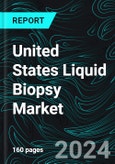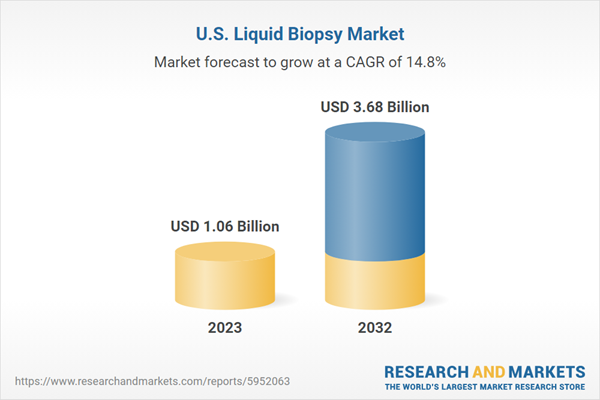Liquid biopsy is prevalent in healthcare. It is non-invasive and detects biomarkers in blood or urine. This innovative diagnostic approach gives a much less worrying alternative to traditional tissue biopsies. It is mainly used for cancer detection and tracking. Its versatility extends past oncology, with programs in prenatal testing, infectious illnesses, and organ transplant monitoring. Liquid biopsy revolutionizes the care of patients and provides well-timed and personalized remedy strategies. This is because of ongoing improvements in technology and research.
United States Liquid Biopsy Growth Drivers
Growing Cases of Cancer
Cancer is a global pandemic. The NIH expected that in 2023, about 2.0 million people could be identified with cancer in the United States. An assessed 297,790 women and 2,800 men can be analyzed with breast cancer, which makes it the most standard cancer prognosis. Prostate cancer is the leading cancer analysis amongst men and the second most common analysis, with 288,300 anticipated instances. Lung and bronchus cancer is the third most typical cancer diagnosis, with an expected 238,340 new cases. The high incidence is propelling the United States liquid biopsy market. Evaluating cancer-related alerts using biological fluids (liquid biopsy) has generated substantial interest in the past decade. Liquid biopsies can discover a vast range of biomolecular components and feature the capability to indicate ailment status.Increasing acceptance of Non-invasive Techniques
The rising field of liquid biopsy is at the forefront of novel diagnostic techniques for cancer and different diseases. Liquid biopsy facilitates a minimally invasive molecular definition of cancer for diagnosis, patient level to treatment, and longitudinal monitoring. Strategies encompass detecting and monitoring circulating tumor cells, cellular-free DNA, and extracellular vesicles. The NIH article observed that in the United States, in 2017, 9.8 million inpatient principal operating room methods were analyzed, of which 11.1% had been minimally invasive and 2.5% have been robot-assisted, compared with 9.6 million inpatient operating room techniques (11.2% minimally invasive and 2.9% robot-assisted) in 2018. There were 10.6, 10.6, and 10.7 million ambulatory procedures in 2016, 2017, and 2018, respectively. Ambulatory MIS processes grew, representing 16.9%, 17.4%, and 18%, respectively. This upward thrust is anticipated to add to the growth of the United States liquid biopsy market.Emphasis on Companion Diagnostics
Companion diagnostics are in-vitro methods that offer facts about the suitability and effectiveness of a selected healing drug for an affected person before its administration. Therefore, they permit the stratification of affected person populations. Their multiplied utilization is propelling the United States liquid biopsy market. In January 2023, the FDA granted companion diagnostic designation to FoundationOne Liquid CDx to help in figuring out ROS1-superb non-small mobile lung cancer (NSCLC) or NTRK fusion-positive solid malignancies that may be handled with entrectinib (Rozlytrek). FoundationOne Liquid CDx is a next-generation sequencing-based in vitro diagnostic that analyzes 324 genes through circulating cell-free DNA by targeting throughput hybridization-based plasma derived from anti-coagulated peripheral whole blood in a population with advanced disorders.Progress in Technology
Advancements like next-generation sequencing (NGS) drive liquid biopsy evolution. This permits precise evaluation of circulating tumor cells (CTCs) and cell-free DNA (cfDNA). These innovations enhance cancer detection and monitoring and propel the United States liquid biopsy market. Healthcare companies leverage NGS to benefit from deep insights into tumor biology and genetic mutations. This guides personalized remedies and improves results. In November 2023, Illumina Inc. introduced TruSight™ Oncology 500 ctDNA v2, expanding noninvasive complete genomic profiling (CGP) of circulating tumor DNA (ctDNA) for cases where tissue testing is unavailable or supplements tissue-based assays.Breast Cancer could emerge as a notable focus within the Market
Breast cancer might stand out as a distinguished concern in the United States liquid biopsy market. The demand pushes this for less-invasive early detection and monitoring diagnostic strategies. Approximately 13% of American women are projected to develop invasive breast cancer at some stage in their lifetime. An estimated 297,790 new instances of invasive breast cancer and 55,720 cases of DCIS are predicted among U.S. women in 2023. Liquid biopsies provide a minimally invasive technique for acquiring essential diagnostic information. This is highly beneficial for people affected by breast cancer.United States Liquid Biopsy Company News
Thermo Fisher Scientific Inc., Roche Diagnostics, Bio-Rad Laboratories Inc., Biocept, Inc., Biocartis, Myriad Genetics, Inc., Exact Sciences (Genomic Health), NeoGenomics Laboratories, and Quest Diagnostic Inc. are the leading businesses in the United States liquid biopsy market.- In October 2023 - The FDA approved Foundation Medicine's FoundationOne®CDx and FoundationOne®Liquid CDx as companion diagnostics for Pfizer’s BRAFTOVI® and MEKTOVI® to detect BRAF V600E mutation in metastatic non-small cell lung cancer. ClearNote Health™'s Avantect™ Pancreatic Cancer Test received a new CPT code, 0410U, facilitating reimbursement, with CMS's proposed reimbursement rate of US$ 1,160, effective January 1, 2024.
- In October 2023 - Researchers from the UCLA Jonsson Comprehensive Cancer Center and the UCLA School of Dentistry secured a US$ 4.6 Million grant from the National Cancer Institute. Over five years, they will enhance liquid biopsy technologies to detect lung cancer early, addressing its status as the primary cause of cancer-related deaths in American men and women.
- In September 2023 - Exact Sciences intends to utilize its impending purchase of Resolution Bioscience to enter the next-generation sequencing-based liquid biopsy market, offering tests that complement its existing tissue-based test offerings.
- In April 2023 - Quest Diagnostics announced its agreement to acquire Haystack Oncology, a startup specializing in early-stage liquid biopsy testing for detecting residual or recurring cancer, for up to US$ 450 Million.
- In April 2023 - QIAGEN introduced the QIAseq Targeted cfDNA Ultra Panels for cancer and disease research, expediting the conversion of cfDNA liquid-biopsy samples to NGS-ready libraries in under eight hours. This addition to the QIAseq Targeted DNA product line will be showcased at QIAGEN's offerings during the 2023 American Association for Cancer Research (AACR) annual meeting in Orlando, Florida, from April 14 to 19, 2023.
Cancer Types - Market breakup in 6 viewpoints:
1. Lung Cancer2. Breast Cancer
3. Colorectal Cancer
4. Prostate Cancer
5. Liver Cancer
6. Other Cancer
Products - Market breakup in 3 viewpoints:
1. Kits & Reagents2. Platforms & Instruments
3. Services
Application - Market breakup in 3 viewpoints:
1. Early Diagnosis2. Patient Monitoring
3. Recurrence Monitoring
Biomarkers - Market breakup in 3 viewpoints:
1. Circulating Tumor Cells (CTCs)2. Circulating Tumor DNA (ctDNA)
3. Extracellular Vesicles (EVs)
Sample Types - Market breakup in 3 viewpoints:
1. Blood2. Urine
3. Others
End-Users - Market breakup in 2 viewpoints:
1. Hospitals & Laboratories2. Governments & Academic Research Centers
All the key players have been covered from 3 viewpoints:
- Overview
- Recent Development
- Revenue Analysis
Company Analysis:
1. Thermo Fisher Scientific Inc.2. Roche Diagnostics
3. Bio-Rad Laboratories Inc.
4. Biocept, Inc.
5. Biocartis
6. Myriad Genetics, Inc.
7. Exact Sciences (Genomic Health)
8. NeoGenomics Laboratories
9. Quest Diagnostic Inc.
Table of Contents
Companies Mentioned
- Thermo Fisher Scientific Inc.
- Roche Diagnostics
- Bio-Rad Laboratories Inc.
- Biocept, Inc.
- Biocartis
- Myriad Genetics, Inc.
- Exact Sciences (Genomic Health)
- NeoGenomics Laboratories
- Quest Diagnostic Inc.
Methodology
In this report, for analyzing the future trends for the studied market during the forecast period, the publisher has incorporated rigorous statistical and econometric methods, further scrutinized by secondary, primary sources and by in-house experts, supported through their extensive data intelligence repository. The market is studied holistically from both demand and supply-side perspectives. This is carried out to analyze both end-user and producer behavior patterns, in the review period, which affects price, demand and consumption trends. As the study demands to analyze the long-term nature of the market, the identification of factors influencing the market is based on the fundamentality of the study market.
Through secondary and primary researches, which largely include interviews with industry participants, reliable statistics, and regional intelligence, are identified and are transformed to quantitative data through data extraction, and further applied for inferential purposes. The publisher's in-house industry experts play an instrumental role in designing analytic tools and models, tailored to the requirements of a particular industry segment. These analytical tools and models sanitize the data & statistics and enhance the accuracy of their recommendations and advice.
Primary Research
The primary purpose of this phase is to extract qualitative information regarding the market from the key industry leaders. The primary research efforts include reaching out to participants through mail, tele-conversations, referrals, professional networks, and face-to-face interactions. The publisher also established professional corporate relations with various companies that allow us greater flexibility for reaching out to industry participants and commentators for interviews and discussions, fulfilling the following functions:
- Validates and improves the data quality and strengthens research proceeds
- Further develop the analyst team’s market understanding and expertise
- Supplies authentic information about market size, share, growth, and forecast
The researcher's primary research interview and discussion panels are typically composed of the most experienced industry members. These participants include, however, are not limited to:
- Chief executives and VPs of leading corporations specific to the industry
- Product and sales managers or country heads; channel partners and top level distributors; banking, investment, and valuation experts
- Key opinion leaders (KOLs)
Secondary Research
The publisher refers to a broad array of industry sources for their secondary research, which typically includes, however, is not limited to:
- Company SEC filings, annual reports, company websites, broker & financial reports, and investor presentations for competitive scenario and shape of the industry
- Patent and regulatory databases for understanding of technical & legal developments
- Scientific and technical writings for product information and related preemptions
- Regional government and statistical databases for macro analysis
- Authentic new articles, webcasts, and other related releases for market evaluation
- Internal and external proprietary databases, key market indicators, and relevant press releases for market estimates and forecasts

LOADING...
Table Information
| Report Attribute | Details |
|---|---|
| No. of Pages | 160 |
| Published | April 2024 |
| Forecast Period | 2023 - 2032 |
| Estimated Market Value ( USD | $ 1.06 Billion |
| Forecasted Market Value ( USD | $ 3.68 Billion |
| Compound Annual Growth Rate | 14.8% |
| Regions Covered | United States |
| No. of Companies Mentioned | 9 |









